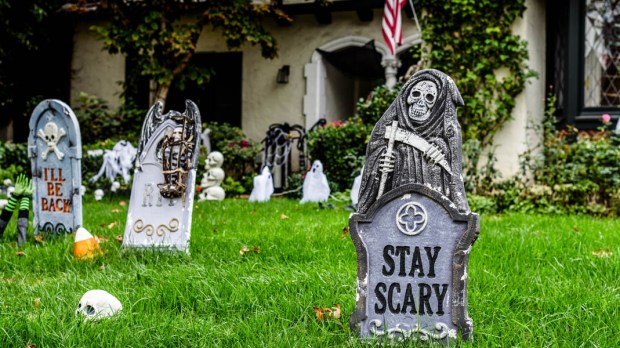The graves in the front yards, that was weird and kind of creepy. And the humans hanging from trees and the bloody decapitated heads lying on the lawn. And the torture devices. So was the number of families who went all out to decorate for Halloween, and the amount of decorations they put up.
We’d moved in the middle of October from a town near Boston, where the people who bothered put up a cardboard ghost or witch, and a jack-o’lantern if they were energetic enough to carve one. The few people who did much more were thought to be a little eccentric, but it takes all kinds, etc.
We’d moved to a town outside Pittsburgh. Our new neighbors decorated more for Halloween than I had ever seen anyone do for Christmas. A lot more. Most were Catholic, in the sense that the Catholic parish was the church they rarely went to.
I shrugged. It was different culture. Who knew what they did in the Midwest and why? Still, weird and creepy. I haven’t lost that feeling in all the years we’ve lived here.
The adult investment
The journalist Matthew Gindin shrugged too, until he had a child. Now, he writes in Forward, “I have a hard time imagining why I would want to expose my son to images of murder, death, evil, and supernatural terror for purposes of recreation.”
Gindin felt this even more strongly when he became a journalist and spent more time looking closely at evil. He mentions “a woman this week who put her two toddlers in the oven and turned it on.” He thinks of these stories when he sees the Halloween decorations, like windows with fake victims’ bloody handprints.
People will tell him he’s making too much of this. No, he says, he’s not. He worries about “the increasing adult investment in Halloween, which for a week or two makes ‘horror culture’ pervasive and provokes competition for the coolest gory and menacing symbols of madness, supernatural or irrational evil, and violence.”
I’m not making a point in the annual Halloween war. It’s not the use of the supernatural that bothers me, were it only the cartoon ghosts and witches I saw in New England. It’s the love of violence as entertainment. That includes supernatural violence but also a lot of natural violence not a traditional part of Halloween.
He’s not making too much of it, Gindin says. Other people make too little of it. “It is the ability to celebrate and enjoy images of violence and evil that signifies an excess of superficiality.”
That, I think, is the problem, the thing that makes the decorations weird and creepy. The people with the gory decorations raise in a frivolous way what Gindin calls “the possibility of irrational horror arising from nowhere and swallowing up all that is good in the world.”
They’re not play-acting in the innocent way a child with a sheet over his head pretends to be a ghost. They’re play-acting in the way someone dresses like Stalin or Hitler at a costume party. The fact that he thinks it’s all in fun doesn’t change the fact that he’s play-acting genuine evil.
Maybe we over-react
Maybe Gindin and I over-analyze and over-react. Maybe we’re just grumpy old men. I would have said that when I was younger, telling myself that the decorations weirded me out because they were so different from anything I knew, but it takes all kinds.
I would have said we can separate play from reality. The little boy dressed as a pirate doesn’t want to kill, rape, and pillage, and the little girl dressed as a witch doesn’t want to curse people’s lives. The same applied to the over-decorated houses. I admit also to having wanted very much to avoid being the kind of Christian who seeks things to reject as a badge of their Christianity.
Now, older, I’m not so blithe about it. I intuit that a line has been crossed when people advertise and enjoy violence even in the unreal and unserious act of decorating their houses with graveyards and torture devices and bloody handprints on the windows. St. Paul’s instruction to the Christians in Philippi seems ever more crucial. “Now, brethren, all that rings true, all that commands reverence, and all that makes for right,” he says (I’m using Ronald Knox’s translation), “all that is pure, all that is lovely, all that is gracious in the telling; virtue and merit, wherever virtue and merit are to be found — let this be the argument of your thoughts.”
Gindin describes one result of the thing that I think bothers both of us. This might make my intuition more concrete. “A couple of years ago in Germany,” he writes,
when parents objected to a giant billboard of a leering, decomposing skeleton head hanging above their children’s school route, there was a loud backlash about “freedoms’ and the sign was kept up. (It was an advertisement for Iron Maiden’s last album.) What a strange world to live in when the freedoms of adults carry so much more weight than the pedagogy of children, so much more gravitas then the natural concern of parents to not giving them more nightmares than the world has already promised.

